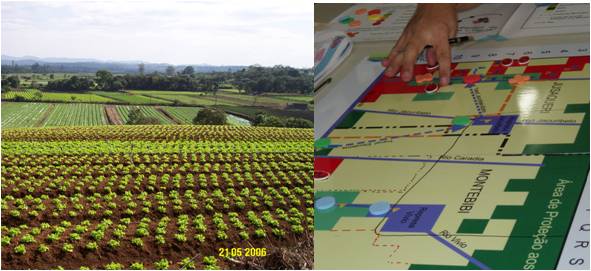|
|

|
Managing water in a peri-urban catchment area
 The Alto Tietê Cabeiceras is a complex catchment area in the water
supply system for the Sao Paulo metropolis, including huge hydraulic infrastructures
(five reservoirs, large channels and pumping station) covering several
municipalities. The water quality in the final reservoir is constantly
being degraded by eutrophication, which results in increased treatment
costs. Studies have shown that this pollution is due mainly to the modalities
of managing water transfers between reservoirs, whilst traditionally the
managers accuse illegal urban development and diffuse agriculture.
The Alto Tietê Cabeiceras is a complex catchment area in the water
supply system for the Sao Paulo metropolis, including huge hydraulic infrastructures
(five reservoirs, large channels and pumping station) covering several
municipalities. The water quality in the final reservoir is constantly
being degraded by eutrophication, which results in increased treatment
costs. Studies have shown that this pollution is due mainly to the modalities
of managing water transfers between reservoirs, whilst traditionally the
managers accuse illegal urban development and diffuse agriculture.
In this context, a four-stage ComMod approach was applied as part of the dialogue within a cactchment committee about integrated management of the water resource, by addressing water quality and small scale agriculture aspects:
-
Themed studies (hydrology, land economics, agro-economy, social sciences, geography, etc.) improving the understanding of water management and pollution dynamics at the scale of the catchment area;
-
Co-constructing a discussion tool in the form of the AguAloca role play, mobilising a multi-discipline team and a small group of managers;
-
Specific work with farmers to boost their ability to face up to the tensions surround (?) the water in this catchment area and take part in discussion bodies;
- Using the AguAloca game twice: once with engineers from the water company, the water management department and municipality representatives and once with several members of the Alto Tiete basin committee.
The approach helped participants understand better the meaning of the "integrated water" management concept at the scale of a catchment area, by giving them a chance to analyse the interdependences, particularly in terms of water allocation and changes in its quality. It also drew attention to the agricultural and rural issue in this peri-urban region. The game appeared to be an interesting way of introducing the complexity of managing a catchment area to newcomers to the discussions bodies and of preparing the stakeholders in the use of simulation tools calibrated to reality.
For further information: A seminar presentation: (Clavel et al., 2008)
| Last update: January
5, 2010 |
|
|

